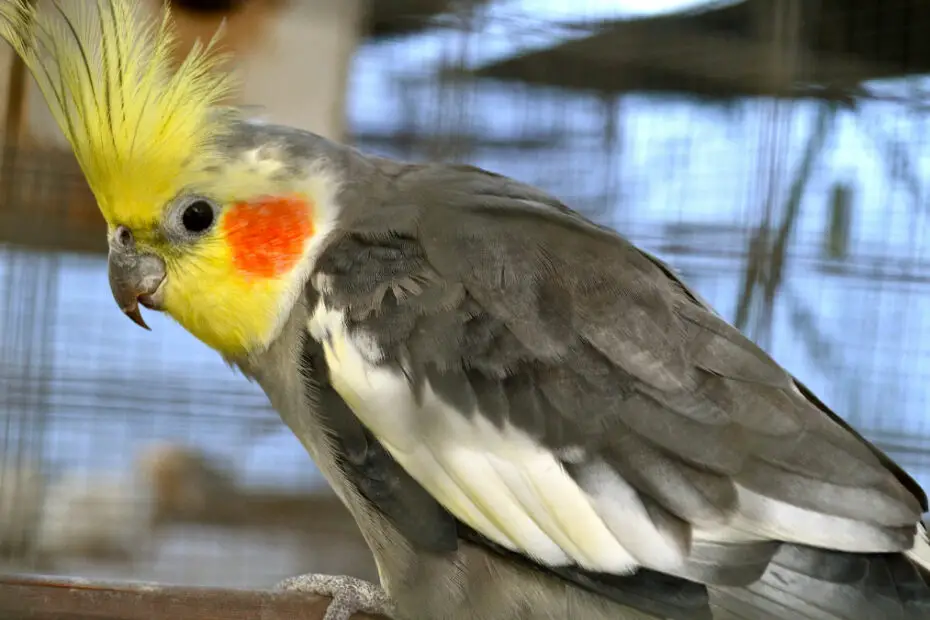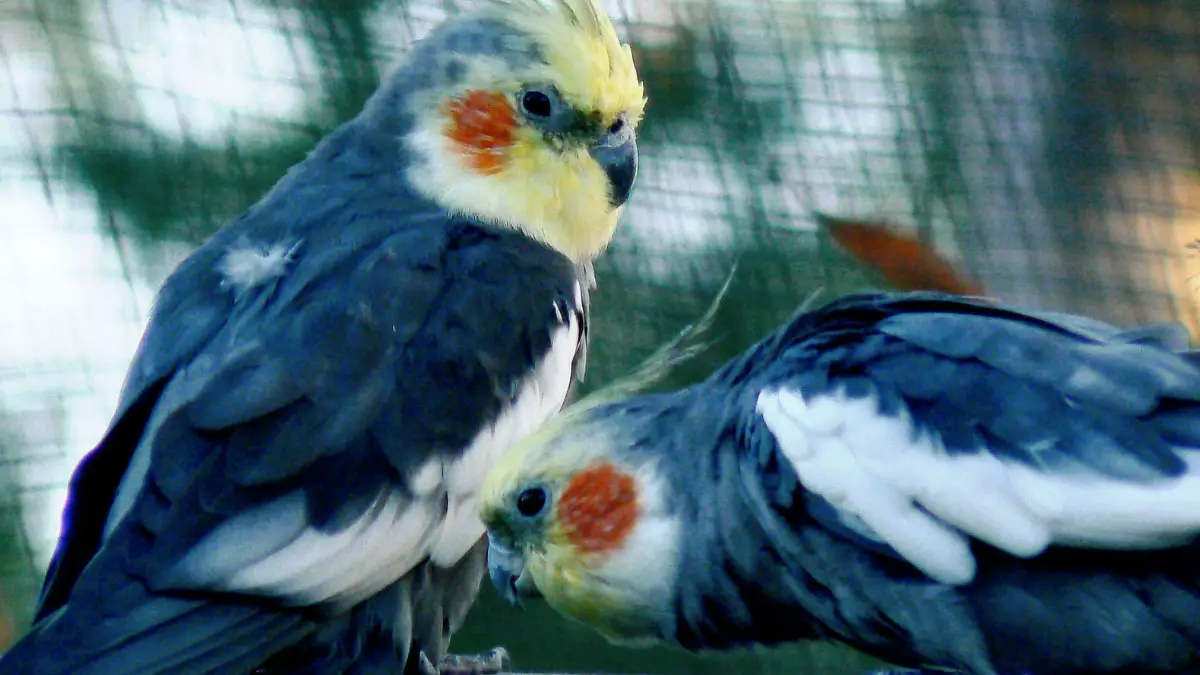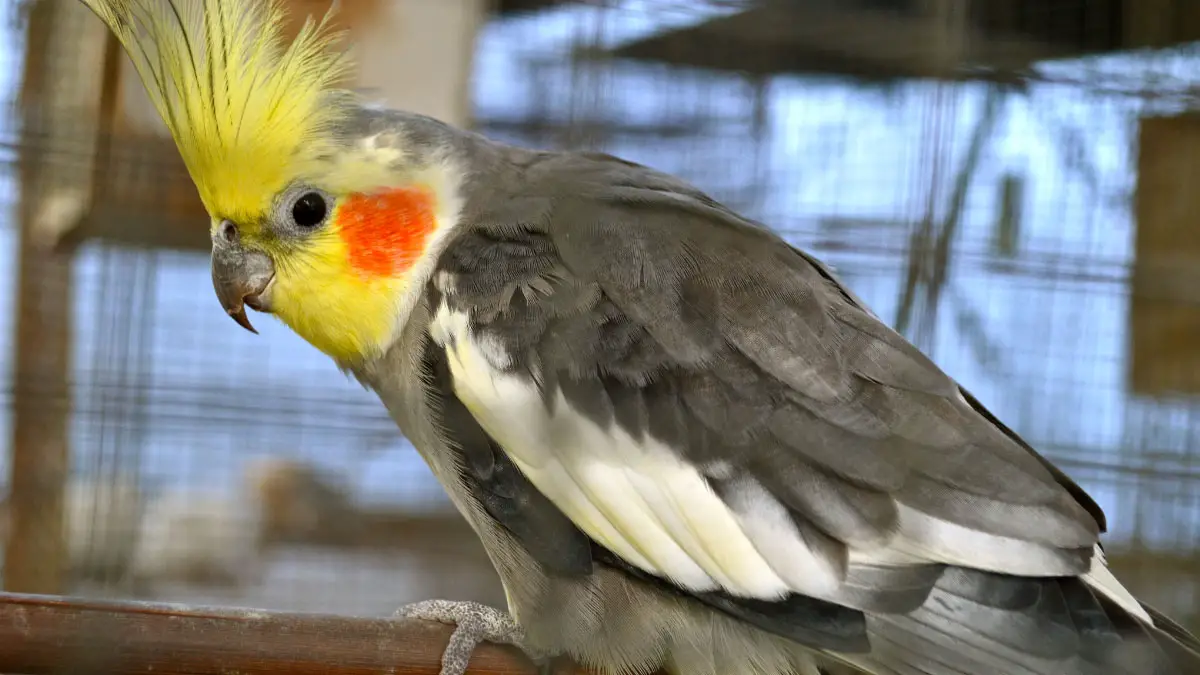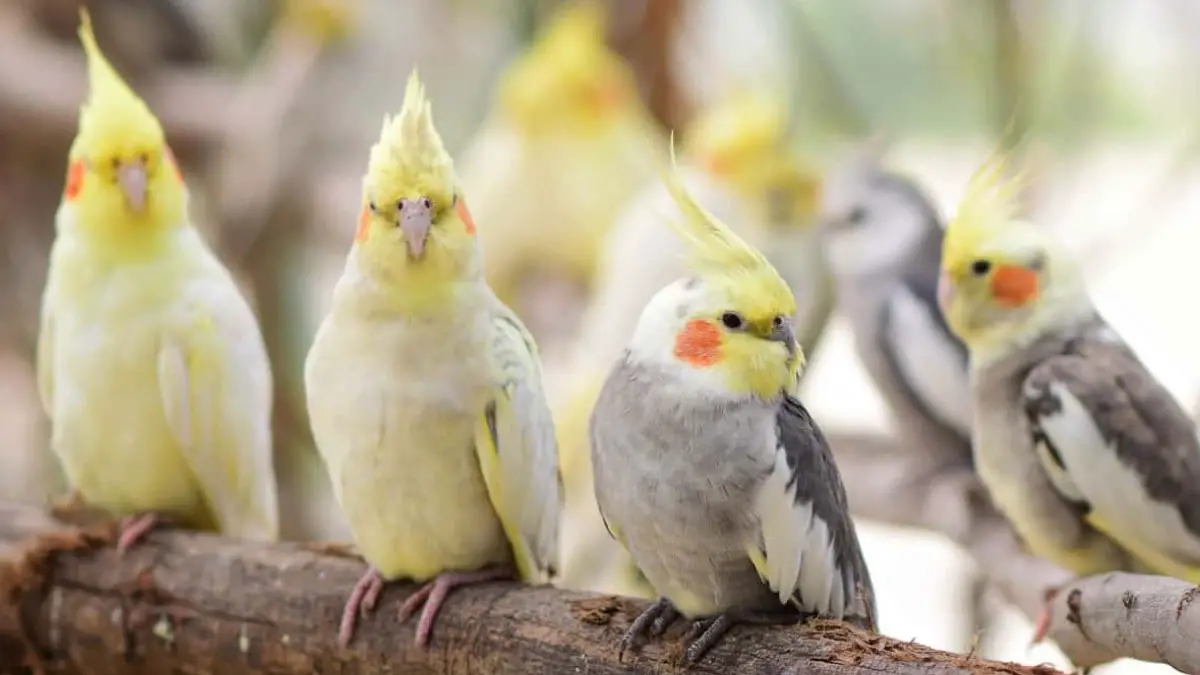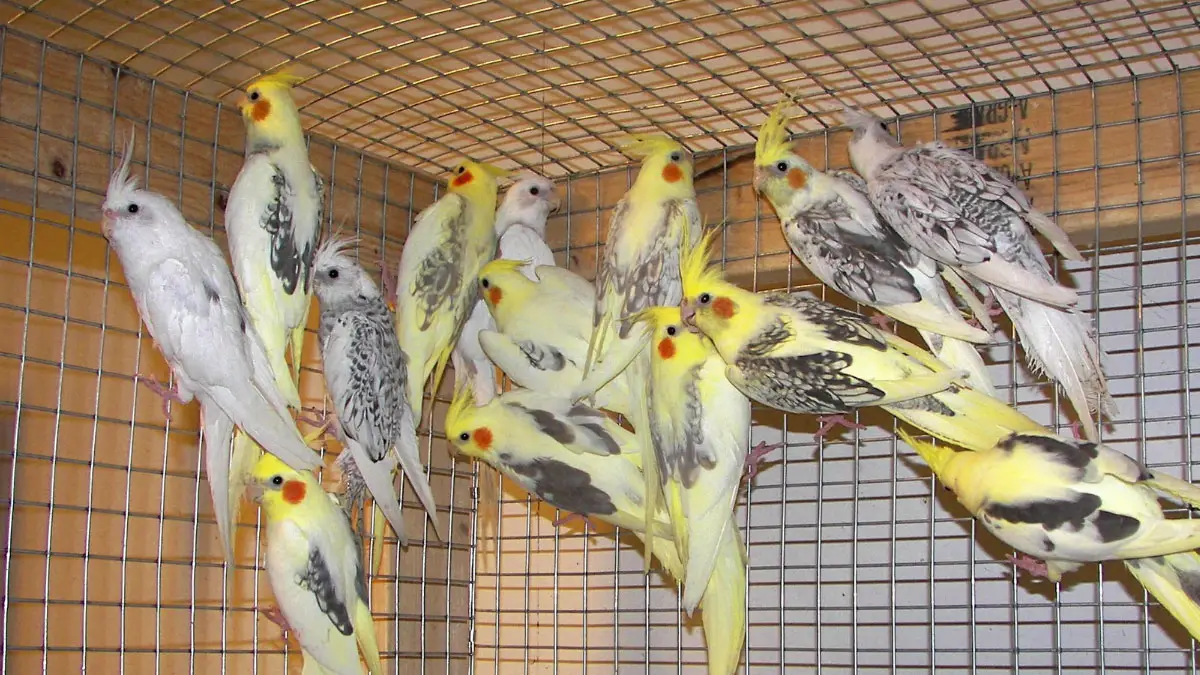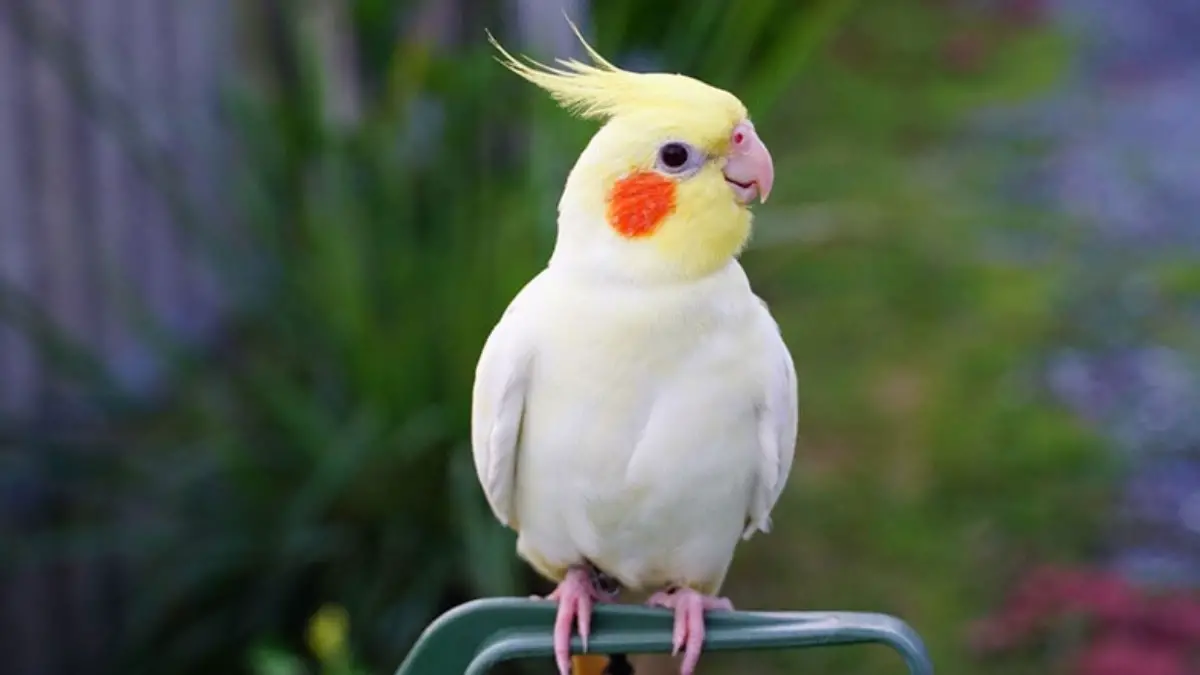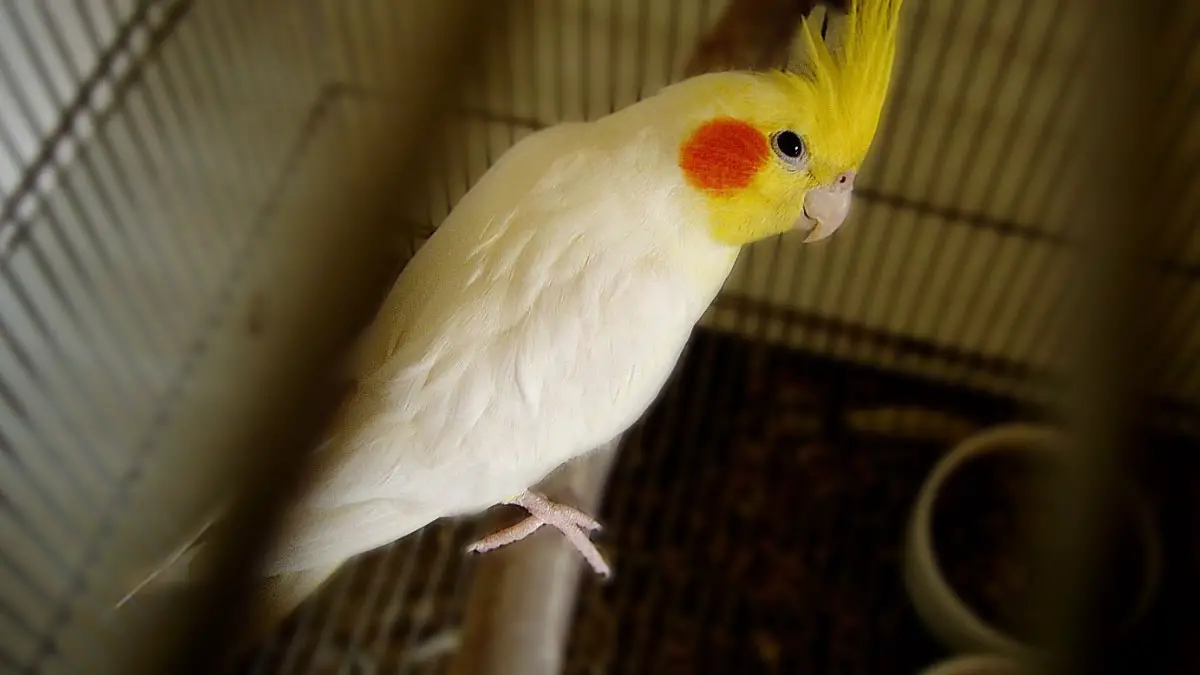Keeping a pet cockatiel is a joyous and fulfilling experience, but it also comes with responsibilities, and one crucial aspect is grooming and hygiene. Like humans, these birds require regular grooming to maintain their health and well-being.
Grooming is vital in preventing diseases, maintaining feather health, and improving your bird’s overall quality of life. Proper grooming keeps your pet looking good and promotes physical and mental health.
Regular preening and bathing behaviors are essential for a cockatiel’s natural behaviors. They help keep their feathers clean, healthy, and in optimal condition for flying insulation, and communication.
This bird hygiene for beginners article will delve into the importance of grooming and hygiene for your pet’s health and well-being. We will explore how grooming can prevent disease, maintain feather health, and improve your bird’s quality of life. We will also provide practical tips on promoting healthy grooming behaviors in your bird.
Cockatiel Feather Care
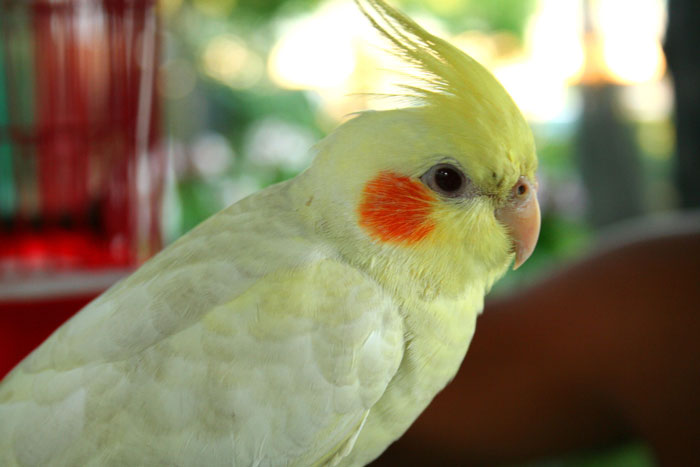
Here are some essential tips on how to properly care for your pet’s feathers:
- Encourage healthy preening: Cockatiels naturally use preening behavior to clean and maintain their feathers. Provide them with toys and perches that encourage this behavior. Use toys with different textures or natural materials like wood or rope.
- Support molting: This is a natural process in which cockatiels shed and grow new feathers. During this time, provide your pet with a balanced diet. Additionally, provide them with a stress-free environment and ample rest.
- Regularly inspect feathers: Check for signs of health issues such as mites, redness, scaly skin, or bald patches. These can indicate underlying health problems that may affect their feather health. If you notice any abnormalities, consult a veterinarian experienced in avian pet care for appropriate treatment options.
- Avoid harsh grooming practices: Excessive pulling or trimming of bird feathers can damage their structure and integrity. If trimming wings or nails, seek guidance from an experienced avian groomer to avoid causing harm.
Identifying and Treating Feather-Related Health Issues in Cockatiels
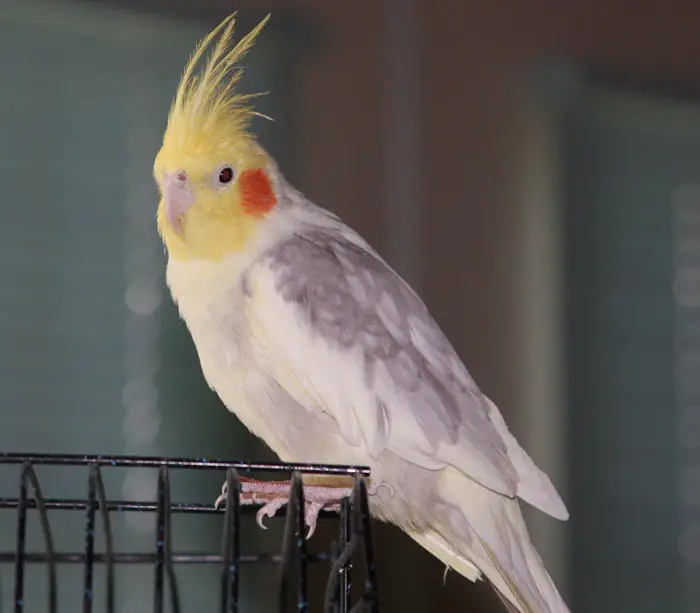
Here are various feather issues and how you can identify plus treat them:
- Mites:
Signs of mite infestation include excessive scratching, feather loss, redness, or skin inflammation. You will also have visible mites on the feathers or skin. If you suspect your pet has mites. Thoroughly clean and disinfect your pet’s living environment. Disinfect perches, toys, and cages to prevent re-infestation.
- Feather plucking:
Feather plucking is a destructive behavior in which a bird excessively preens and damages its feathers. This results in bald patches, broken feathers, and poor feather health.
Various factors, including stress, boredom, illness, or bird nutrition deficiencies, can cause feather plucking. To resolve, identify and resolve any stressors, provide mental and physical stimulation.
- Clip wings:
Cockatiels can sometimes have damaged feathers due to accidents, rough handling, or environmental factors. Damaged feathers may be broken, bent, or frayed and can affect the overall health and appearance of the plumage.
Damaged feathers must be clipped or removed to prevent further harm to the bird.
- Other feather-related health issues:
Cockatiels can also suffer from other feather-related health issues, such as infections, inflammation, or structural abnormalities. Symptoms include cysts, redness, swelling, and tenderness of the bird’s skin.
These require veterinary diagnosis and treatment, including medication or other interventions depending on the specific condition.
Bathing your Cockatiel Appropriately
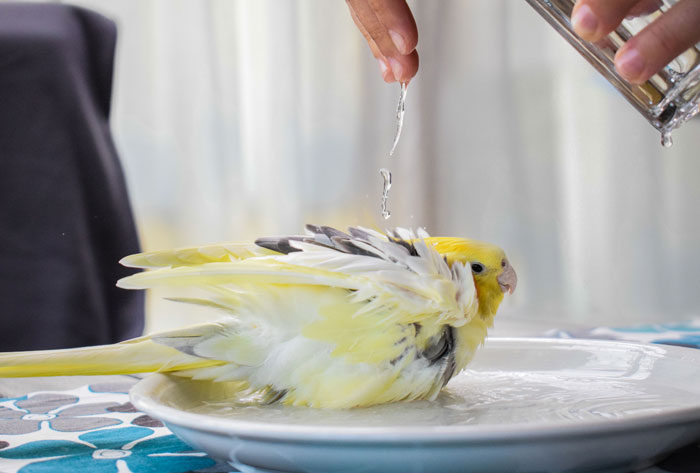
Bathing is essential to bird care as it helps maintain their feather health, cleanliness, and overall well-being. Here are some standard bathing techniques you can use:
- Water bowl: Place a shallow bowl in your pet’s cage or play area. Ensure the water is not too deep and your bird can easily stand and bathe without submerging. Cockatiels may splash, shake their feathers, and preen themselves while bathing in the water bowl.
- Spray bottle: Fill a clean spray bottle with lukewarm water and mist your pet from afar. Cockatiels enjoy being misted with fine water droplets, simulating a natural mist or rain shower. Avoid spraying water directly into your bird’s face or eyes.
- Shower: Some cockatiels enjoy taking showers with their owners. You can use a gentle mist setting on a handheld showerhead or place your pet on a perch in the bathroom while you take a warm shower. The mist and humidity from the shower will help your pet bathe and enjoy the bonding experience with you.
We recommend observing your pet’s preferences to know what kind of bathing your bird likes. Every cockatiel is unique, and their bathing preferences may vary.
Some cockatiel species and breeds, such as the whiteface lutino and ashen fallow, may prefer a shallow water bowl. Others may enjoy being misted with a spray bottle or showering with their owner.
Nail Trimming and Beak Maintenance
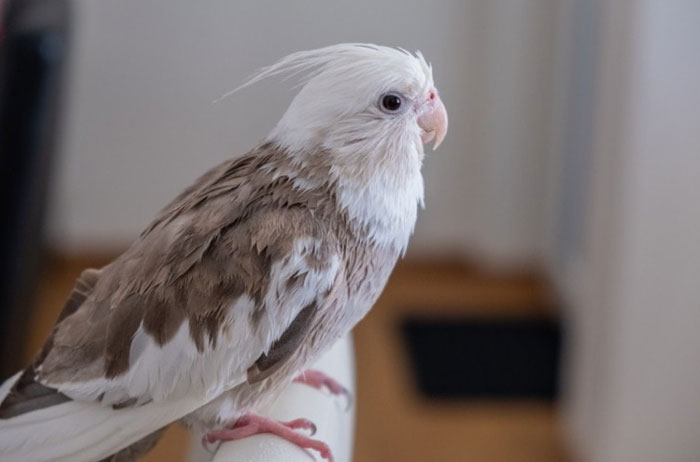
Cockatiels, like all birds, require regular nail cutting and beak care to ensure their health and well-being. To trim their nails, you should do the following jobs.
- Choose the right time: Choose when your bird is relaxed and calm for nail cutting. Avoid trimming your cockatiel’s nails when stressed, anxious, or agitated, as it may result in accidental injury.
- Hold your bird securely: Use a gentle but firm grip to hold your pet securely during nail cutting.
- Trim the tips of the nails: When grooming cockatiels, carefully trim the tips of their nails, avoiding the blood vessels or “quick” that runs through the nails. The quick is the pinkish part of the nail and contains nerves and blood vessels.
You should also not just cut their nails unless they need to be trimmed. You can identify if your cockatiel’s nails need trimming by observing their behavior. If your pet has difficulty perching or gripping onto perches or toys, it may be a sign that its nails have grown too long and need trimming.
Uneven or sharp nails and nails that snag on surfaces such as fabric or carpet can also indicate the need for trimming. Additionally, if your cockatiel’s nails are curling or twisting, it’s a sign that they are too long and need attention.
Choosing the Best Bird Grooming Equipment and Techniques for Nail Care
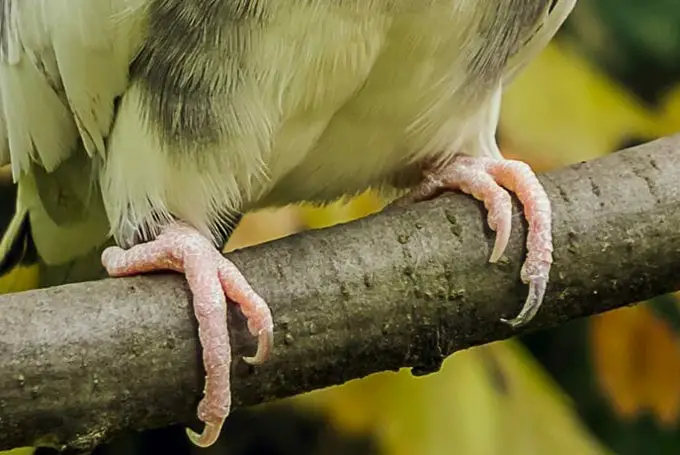
Here are the best tools and techniques for nail cutting your parrot:
- Nail clipping for birds: Choose a pair of sharp, bird-specific nail clippers that are small and easy to handle. Avoid using human nail clippers, scissors, or other sharp objects. They can easily crush or split your bird’s delicate nails, causing injury.
- Nail file: If you prefer not to use nail clippers, you can also use a bird-specific nail file to gently file down your pet’s nails. This should also be designed for birds and not humans.
- Techniques: You can use different techniques to trim your bird’s nails.
- One common approach is to have your cockatiel perched on your finger or hand. Then gently use the nail clippers or file to trim the tips of the nails, avoiding the quick or blood vessels.
- Alternatively, you can have another person gently hold your pet while you trim its nails or wrap it in a towel to secure it during nail cutting.
- Be cautious: When trimming your bird’s nails, especially if you are new to the process, be cautious. It’s better to trim just the tips of the nails and be conservative rather than risk cutting into “the quick,” which can cause pain and bleeding.
Maintaining Healthy Cockatiel Beak
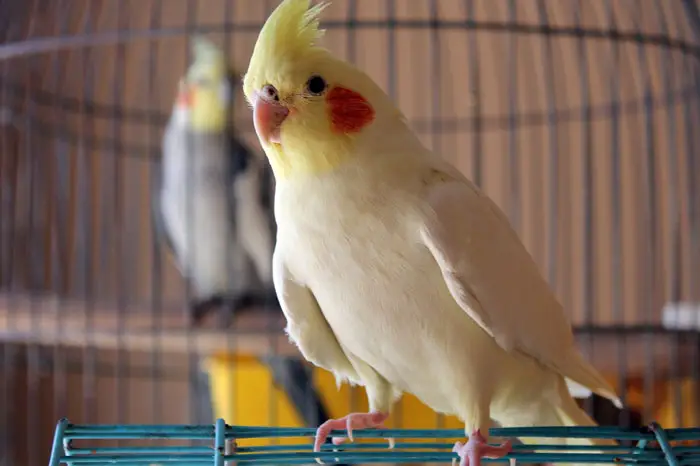
Follow these tips to have a healthy bird beak:
- Appropriate diet: Cockatiels should have access to a varied diet that includes high-quality pellets, fresh vegetables, fruits, and seeds. Avoid feeding your pet a diet high in processed foods and sugary treats.
- Provide chewing opportunities: Cockatiels naturally love to chew. So, offer them bird-safe toys, perches, and branches. Avoid using materials that can splinter or cause injury to your bird, such as plastic or metal.
- Regular beak trimming: In some cases, cockatiels may require beak trimming, especially if their beaks are overgrown or misaligned. Do not trim your pet’s beak at home without proper knowledge and tools.
- Monitor beak-related health issues: Beak-related health issues in cockatiels can include beak overgrowth, beak deformities, beak injuries, and beak infections. Signs of beak-related health issues are changes in beak shape, cracks, splits, bleeding, swelling, discharge, or difficulty eating.
If you notice any abnormalities in your cockatiel’s beak, consult a qualified avian veterinarian for proper diagnosis and treatment.
Identifying and Treating Common Nail and Beak Diseases
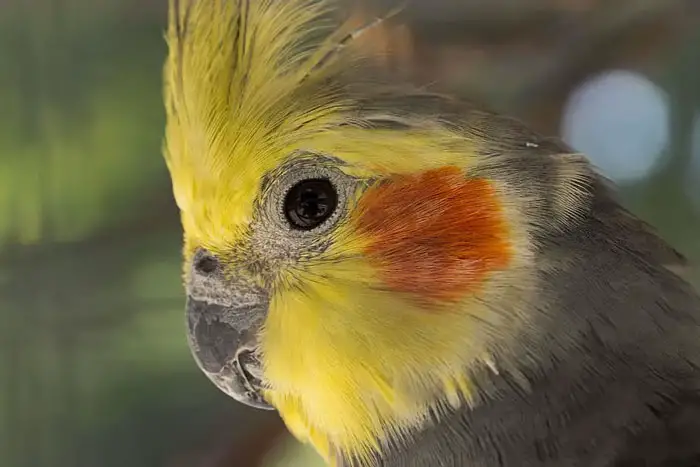
Here are common nail and beak diseases and how to treat them:
- Nail infections: Cockatiels can develop bacterial or fungal infections in their nails, resulting in swelling, redness, or discharge. If you notice any signs of infection, it’s essential to seek veterinary care promptly. Treatment may include antibiotics, antifungal medications, or other appropriate interventions.
- Overgrown nails: Cockatiels with overgrown nails are at risk of snagging or breaking them, which can be painful and lead to infections. Regular nail cutting can help prevent overgrowth. But if the nails have become severely overgrown, it’s best to seek veterinary assistance to avoid causing injury to the bird during trimming.
- Beak abnormalities: Cockatiels can have beak abnormalities such as overgrowth, malformation, or chipping. These can affect their ability to eat, groom, or engage in expected behaviors. Beak abnormalities require veterinary attention. They can be managed through beak trimming, reshaping, or other appropriate treatments.
- Beak injuries: Cockatiels can injure their beaks in accidents, fights, or other reasons. They may get fractures, lacerations, or other types of damage. Immediate veterinary care is needed to assess and treat the injury to prevent further complications.
Environmental Enrichment for Grooming
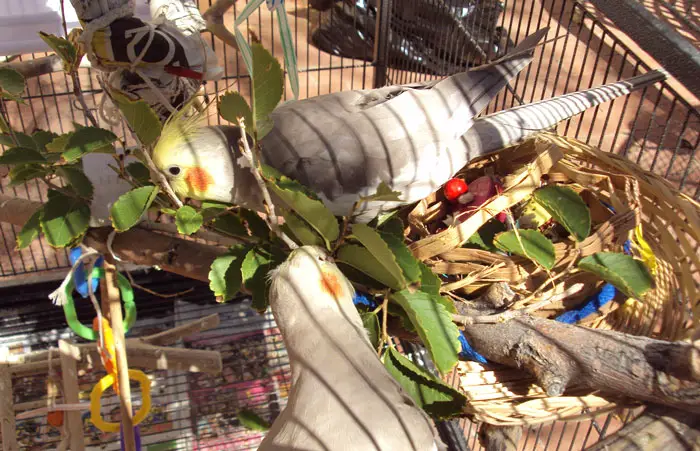
Use these pointers to create a stimulating and safe living environment to support grooming your feathered friend.
- Cage Setup: Provide a spacious cage that allows your pet to move around, stretch its wings, and exercise. The cage should have appropriate bar spacing to prevent escape or injury.
It should also be made of safe and non-toxic materials. Place perches at varying heights to encourage natural perching bird behavior. This also allows your pet to exercise its feet and trim its nails naturally.
- Bedding and Cleaning: Use safe and appropriate bedding materials, such as newspaper or paper-based ones. You should place papers at the bottom of the cage to absorb droppings and make cleaning easier.
Avoid using cedar or pine shavings, as they can harm birds. Clean the cage and replace the bedding regularly to maintain a clean and hygienic environment for your pet.
- Keeping pet birds clean: Besides keeping their cage and toys clean, you should also ensure your birds are clean. Bath them one or two times every week.
- Enrichment and Toys: Cockatiels are curious and intelligent birds that thrive on mental stimulation. Provide a variety of toys, perches, and climbing opportunities to keep your pet mentally engaged and physically active.
Toys such as bells, swings, ropes, and foraging toys can provide mental and physical exercise. Additionally, they can prevent boredom and encourage natural bird grooming behaviors.
Choosing Appropriate Perches and Toys for Cockatiel Beak and Feather Maintenance
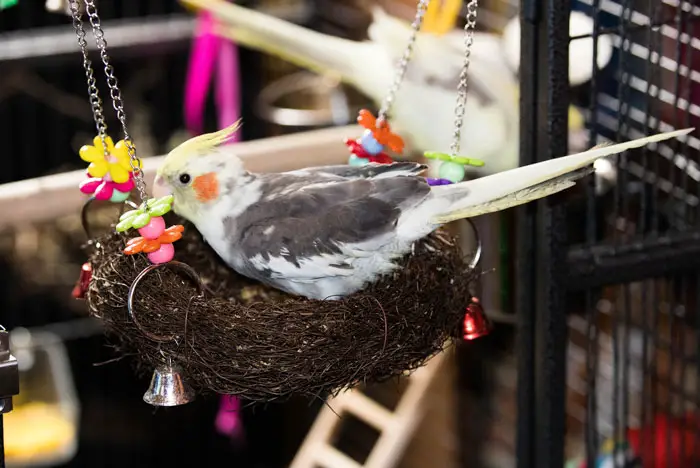
Here are some tips for selecting and maintaining perches and toys for your feathered friend:
- Variety: Offer a variety of perches and toys with different diameters, textures, and heights to encourage natural behaviors and exercise your pet’s feet and beak.
- Size and Shape: Choose bird accessories that are appropriate in size for your bird, considering its beak strength and overall size. Avoid perches and toys that are too small or too large. These may not be safe or enjoyable for your pet to interact with.
- Material: Ensure that perches and toys are made of bird-safe materials such as natural wood, stainless steel, and untreated ropes. Avoid toys with small parts, sharp edges, or toxic materials. These can pose a choking hazard or harm your pet if ingested.
- Cleaning: Select perches and toys that are easy to clean and maintain. Avoid items with crevices or rough textures that can harbor bacteria or make cleaning difficult. Regularly clean perches and toys to remove droppings, feathers, and any other debris.
- Variety: Have a variety of toys that offer different textures, shapes, and difficulty levels. Toys encouraging foraging, chewing, and preening behaviors can help promote healthy beak and feather maintenance.
- Rotation: Regularly rotate and rearrange perches and toys to keep your bird engaged and prevent boredom. This can also help distribute wear and tear on items, ensuring they effectively promote physical and mental exercise.
Promoting Healthy Behaviors in Cockatiels Through Environment Enrichment
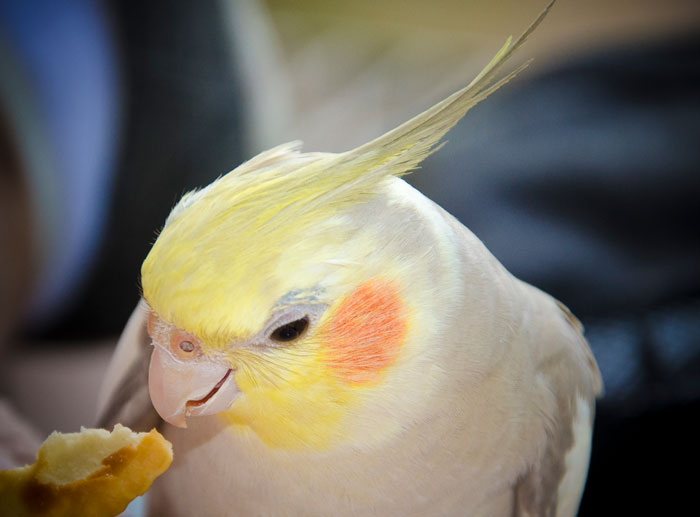
To promote healthy behavior through environmental enrichment, we recommend the following:
- Offer opportunities for exercise: You can do so by giving your bird access to a spacious and safe environment for flying and climbing. You should also offer toys for play and exploration, and encourage short periods of supervised out-of-cage time for exercise.
- Offer social interaction: Bird psychology shows that cockatiels are social birds. Spend time bonding with your bird through talking, singing, and gentle handling. Cockatiels also enjoy observing human activities. They will benefit from being placed in a central area of your home where they can observe and interact with family members.
- Create a safe environment: Remove any hazards, such as toxic plants, sharp objects, and small items that can be ingested. Regularly check for potential hazards and make necessary adjustments to prevent accidents or injuries. Also, clean their cages regularly to promote health.
FAQs
Here are answers to some of the most frequently asked questions about cockatiel grooming.
Cockatiels may groom themselves in the wilderness. However, in captivity, they can’t do it all by themselves. Also, those that are older, sick, or have limited mobility require more assistance with grooming. You will need to trim their nails, clean their cages, help them with their feathers and so on.
The frequency of bathing for cockatiels depends on individual preferences and needs. Some cockatiels enjoy regular baths, while others may not like getting wet. The same applies to the bathing technique. Some birds may enjoy a shower while others a water bowl bath.
Trimming cockatiel’s nails can be done at home if you know the proper techniques. You should also have the appropriate tools, such as nail clippers for birds. However, if you are inexperienced or nervous about causing injury to your bird, it’s best to seek veterinary assistance.
Yes, it is a sign of health issues. Cockatiels may over-groom themselves due to stress, boredom, skin irritation, hormonal imbalances, or other underlying health conditions. This will cause excessive feather plucking, bare patches, or signs of self-mutilation.
You should adopt a good bird health management strategy. This includes providing a clean and stimulating environment and offering a variety of perches with different textures. You should also provide toys for preening and chewing and maintain a balanced diet to ensure healthy feathers and skin.
Conclusion
Proper grooming and hygiene are essential for maintaining the health and well-being of your pet bird. You should adopt regular grooming practices like wing clipping, beak, and nail cutting. You should also provide appropriate perches and toys to help prevent health issues and promote healthy behaviors in your feathered friend.
Regular observation and vigilance, along with seeking veterinary assistance when needed, are essential for addressing any potential health issues related to grooming. Remember always to prioritize the safety and comfort of your bird when engaging in grooming activities.
For further information and resources on cockatiel grooming and bird health, we recommend joining forums dedicated to cockatiels. These include the cockatiel subreddit, Facebook groups on cockatiels, and other online forums.
We also recommend reading cockatiel books such as the Cockatiel Handbook by Matthew M. Vriends. You can also consult a qualified veterinary doctor. Following best practices and seeking reliable resources can provide your feathered friend with a safe and stimulating environment.
